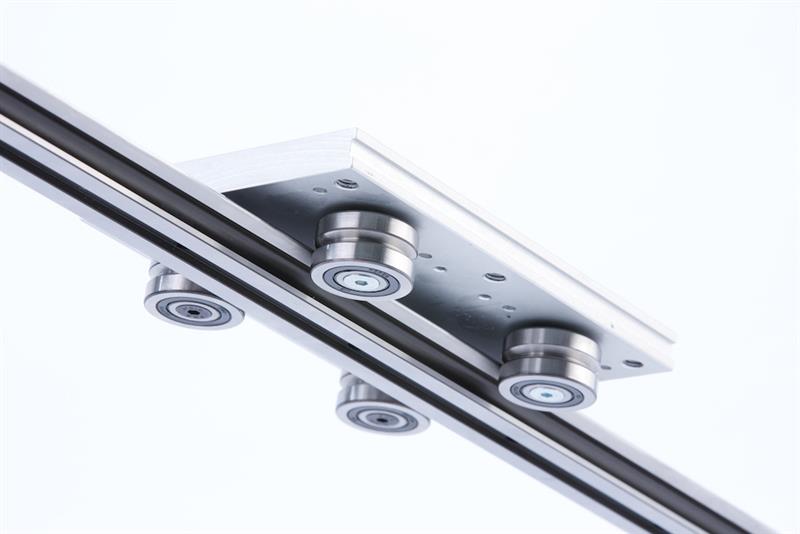Ball rails, or profile rails depending in your preference in terminology, are often the default choice when a linear system is required. Why not – after all they are reliable and proven. Other options, however, are available. And when performance issues are taken into consideration with cost benefits in terms of installation and maintenance, sometimes that alternative can turn out to be a better choice.
One such alternative, while not new and is often overlooked largely due to this market inertia as well as preconceptions about the load bearing capabilities, is the V-guide.
Chris Rees is sales director with HepcoMotion, the company that invented V-guide technology and which now deploys it in its flagship linear motion product, the GV3.A typical scenario is when a machine designer, needing a guidance system, automatically selects the THK type guide rail – the profile rail – as the default choice. Rees commented: "What we say is 'okay it's a great product. It's highly successful and does a good job, but have you considered V-guides in this particular application? Because it'll give you low maintenance, it'll be easy to install and it will work in your conditions very well, and it won't catastrophically fail.' The worst thing that can happen is that they will have to change the bearings after so many thousand kilometres".
 Chris Rees from HepcoMotion is a champion of the V-guide system Chris Rees from HepcoMotion is a champion of the V-guide system |
The GV3 is essentially four rotational bearings with a V in them. Two of these bearings are on concentric studs and two on eccentric, allowing easy adjustment onto the guide while removing any system play, resulting in a smooth running, low friction system. In fact HepcoMotion frequently provides the customer with the bearings already set in the carriage plate, meaning there is no adjustment and the system can be bolted directly onto the customer's machine.
Each bearing has a 'cap wiper' which sits under the carriage plate to protect the bearing and provide lubrication to the slide. "The key benefit of that is its low maintenance," said Rees. "It doesn't require a lot of lubrication to run.Basically, customers lubricate the product and they just forget about it. All we're trying to do is to prevent two metals rubbing together totally dry and providing you do that, you've got some lubrication there, the system will just carry on working."
Unlike profile guides the actual bearings are enclosed, which is a key advantages when it comes to maintenance and one that is more pronounced in dirty conditions. "The cap wiper won't totally prevent dirt from getting into the system," explained Rees. "But if it does happen then it's just wiped clean, it doesn't clog up and cause a potential failure. On the other hand if you get dirt into a ball re-circulating system then eventually it will just fail because the balls can't re-circulate. That doesn't happen with this system because the internal workings of the bearing are sealed. The important thing is the running of the bearing V on the V slide, that's where we've got to look at dirt, and it can't build up there because it just basically wipes it clean."
Even then there can be a build up of dirt in the cap wipers. Rees said: "If you get too much dirt in there you might find the friction gets a bit high and you've got to just take the cap wiper off and then just get rid of some of the crud that's in there.But that's no big deal, it's not a failure. In reality that rarely seems to happen because the cap wipers act as scrapers as well."
It is possible to run the system completely dry of lubricant, but that will have an effect on the load capacity. Any system carrying over 20kg needs some level of lubrication.
Load carrying capacity is an issue that is often looked at and Rees acknowledges that, taking a size for size comparison in terms of dynamic load carrying capacity, the V-guide will not compare to a profile rail. "We accept that, but what we do is we size the product to suit the application. In other words, in our discussions with a customer we'll determine what sort of life they want and if they want a life for five years, we select a guidance system which will give them at least five years' life.Whereas the re-circulating system might give them 50 years' life for the same application, but who's going to want a machine that's 50 years' old anyway?So you tend to find that any objections you get regarding load carrying capacity, and that's really the one objection we can get, you can get round by sizing the product to suit."
 |
The nature of the product actually offers a degree of compliance that is not only acceptable but in some cases is desirable. It is not suitable for applications that need precision measured in microns but instead is used, for example, in basic automation packaging machines, printing machines, scientific equipment, picking and placing, working with robots - applications where a little bit of compliance in the machine is actually quite useful, as customers don't want to get engaged in high precision machining just to get the machine to work and they want installation to be as straightforward as possible.
In its simplest form the GV3 is a guide, bearings and a carriage plate, but the system has evolved to offer the designer many options. At the most basic level, if the designer doesn't want the carriage plate but wants it fitted straight onto the machine then it is simply a case of drilling four holes, fit the bearings into the holes and then adjust the eccentrics onto the slide.
At the other end of the scale there are a host of options from mounting beams, different sized carriage plates, to floating and blind hole fixing bearings to both make installation easier and to increase design options. Rees said: "That's part of the benefit - it's very flexible, very flexible."
One particular example of this is incorporating a drive system. Larger travel distances often lend themselves to the use of a rack and pinion drive. If this is not integral with the guidance system then precision parallel setting of a separate rack to the guide is required. In turn this can mean another precision machined surface is needed just to mount the rack.
GV3 double and single edge rails can be supplied with the rack already in position. With the double edge roll this is a separate component fixed to the top of the slide at manufacture whereas with single edge rails the rack is machined into the free back edge of the rail parallel with the V faces.
With the inclusion of a standard rack driven carriage for the double edge system and a pinion supplied to suit the single edge option, the whole aspect of driving the system becomes a simple process that is compact and does not require additional components and setting.
While the last major introduction for the system was the floating bearings, Rees alluded to development work which could see some interesting iterations for the next product generation.





